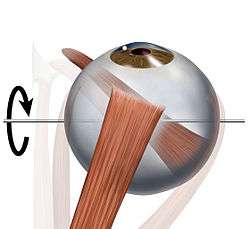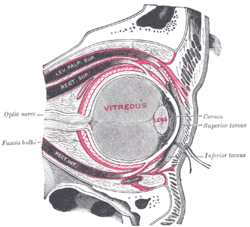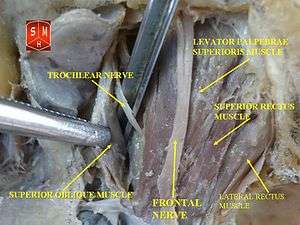Superior rectus muscle
The superior rectus muscle is a muscle in the orbit. It is one of the extraocular muscles. It is innervated by the superior division of the oculomotor nerve (Cranial Nerve III). In the primary position (looking straight ahead), the superior rectus muscle's primary function is elevation, although it also contributes to intorsion and adduction.

The superior rectus muscles is shown in this image of the right eye from above. Hover the mouse over the structures for their names. Click for more information.
| Superior rectus | |
|---|---|
 View of the eye from above, showing the action of the superior rectus muscle. | |
| Details | |
| Origin | annulus of Zinn at the orbital apex |
| Insertion | 7.5 mm superior to the limbus |
| Nerve | oculomotor nerve |
| Actions | elevates, intorsion, and rotates medially the eye |
| Identifiers | |
| Latin | musculus rectus superior bulbi |
| TA | A15.2.07.010 |
| FMA | 49035 |
| Anatomical terms of muscle | |
Structure
Function
It elevates, adducts, and helps intort (rotate medially) the eye.
Clinical significance
Testing
The superior rectus muscle is the only muscle that is capable of elevating the eye when it is in a fully abducted position.[1]
Additional images
 The right eye in sagittal section, showing the fascia bulbi (semidiagrammatic).
The right eye in sagittal section, showing the fascia bulbi (semidiagrammatic). Superior rectus muscle
Superior rectus muscle- Superior rectus muscle
- Extrinsic eye muscle. Nerves of orbita. Deep dissection.
- Extrinsic eye muscle. Nerves of orbita. Deep dissection.
- Extrinsic eye muscle. Nerves of orbita. Deep dissection.
- Extrinsic eye muscle. Nerves of orbita. Deep dissection.
- Extrinsic eye muscle. Nerves of orbita. Deep dissection.
- Extrinsic eye muscle. Nerves of orbita. Deep dissection.
- Extrinsic eye muscle. Nerves of orbita. Deep dissection.
- Extrinsic eye muscle. Nerves of orbita. Deep dissection.
gollark: ***banana***
gollark: Golds/rares of a low generation typically are.
gollark: NOOOOOO!
gollark: ***eggbananalocked***
gollark: Most, really. They get taken eventually, especially as hatchlings.
References
- "Eye Theory". Cim.ucdavis.edu. Retrieved 2012-12-02.
External links
- Anatomy figure: 29:01-02 at Human Anatomy Online, SUNY Downstate Medical Center
- "Diagram". Archived from the original on March 25, 2010.
This article is issued from Wikipedia. The text is licensed under Creative Commons - Attribution - Sharealike. Additional terms may apply for the media files.